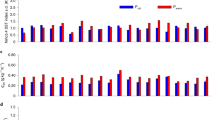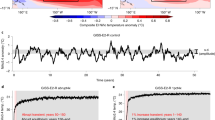Abstract
The hydrological cycle is expected to intensify in response to global warming1,2,3. Yet, little unequivocal evidence of such an acceleration has been found on a global scale4,5,6. This holds in particular for terrestrial evaporation, the crucial return flow of water from land to atmosphere7. Here we use satellite observations to reveal that continental evaporation has increased in northern latitudes, at rates consistent with expectations derived from temperature trends. However, at the global scale, the dynamics of the El Niño/Southern Oscillation (ENSO) have dominated the multi-decadal variability. During El Niño, limitations in terrestrial moisture supply result in vegetation water stress and reduced evaporation in eastern and central Australia, southern Africa and eastern South America. The opposite situation occurs during La Niña. Our results suggest that recent multi-year declines in global average continental evaporation8,9 reflect transitions to El Niño conditions, and are not the consequence of a persistent reorganization of the terrestrial water cycle. Future changes in continental evaporation will be determined by the response of ENSO to changes in global radiative forcing, which still remains highly uncertain10,11.
This is a preview of subscription content, access via your institution
Access options
Subscribe to this journal
Receive 12 print issues and online access
$209.00 per year
only $17.42 per issue
Buy this article
- Purchase on Springer Link
- Instant access to full article PDF
Prices may be subject to local taxes which are calculated during checkout



Similar content being viewed by others
References
Wild, M., Grieser, J. & Schär, C. Combined surface solar brightening and increasing greenhouse effect support recent intensification of the global land-based hydrological cycle. Geophys. Res. Lett. 35, L17706 (2008).
Huntington, T. G. Evidence for intensification of the global water cycle: Review and synthesis. J. Hydrol. 319, 83–95 (2006).
Allen, M. R. & Ingram, W. J. Constraints on future changes in climate and the hydrologic cycle. Nature 419, 224–232 (2002).
Zhang, X. et al. Detection of human influence on twentieth-century precipitation trends. Nature 448, 461–465 (2007).
Durack, P. J., Wijffels, S. E. & Matear, R. J. Ocean salinities reveal strong global water cycle intensification during 1950 to 2000. Science 336, 455–458 (2012).
Chou, C. et al. Increase in the range between wet and dry season precipitation. Nature Geosci. 6, 263–267 (2013).
Dolman, A. J. & De Jeu, R. A. M. Evaporation in focus. Nature Geosci. 3, 296–296 (2010).
Jung, M. et al. Recent decline in the global land evapotranspiration trend due to limited moisture supply. Nature 467, 951–954 (2010).
Mueller, B. et al. Benchmark products for land evapotranspiration: LandFlux-EVAL multi-dataset synthesis. Hydrol. Earth Syst. Sci. 17, 3707–3720 (2013).
Vecchi, G. A. & Wittenberg, A. T. El Niño and our future climate: Where do we stand? WIREs Clim. Change 1, 260–270 (2010).
Collins, M. El Niño- or La Niña-like climate change? Clim. Dyn. 24, 89–104 (2005).
Vautard, R., Cattiaux, J., Yiou, P., Thépaut, J.-N. & Ciais, P. Northern Hemisphere atmospheric stilling partly attributed to an increase in surface roughness. Nature Geosci. 3, 756–761 (2011).
McVicar, T. R. et al. Global review and synthesis of trends in observed terrestrial near-surface wind speeds: Implications for evaporation. J. Hydrol. 416-417, 182–205 (2012).
Seneviratne, S. I. et al. Investigating soil moisture–climate interactions in a changing climate: A review. Earth Sci. Rev. 99, 125–161 (2010).
Teuling, A. J. et al. A regional perspective on trends in continental evaporation. Geophys. Res. Lett. 36, L02404 (2009).
Miralles, D. G., De Jeu, R. A. M., Gash, J. H., Holmes, T. R. H. & Dolman, A. J. Magnitude and variability of land evaporation and its components at the global scale. Hydrol. Earth Syst. Sci. 15, 967–981 (2011).
Fisher, J. B., Tu, K. P. & Baldocchi, D. D. Global estimates of the land-atmosphere water flux based on monthly AVHRR and ISLSCP-II data, validated at 16 FLUXNET sites. Remote Sens. Environ. 112, 901–919 (2008).
Gedney, N. et al. Detection of a direct carbon dioxide effect in continental river runoff records. Nature 439, 835–838 (2006).
Jiménez, C. et al. Global intercomparison of 12 land surface heat flux estimates. J. Geophys. Res. 116, D02102 (2011).
Jiménez, C., Prigent, C. & Aires, F. Toward an estimation of global land surface heat fluxes from multisatellite observations. J. Geophys. Res. 114, D06305 (2009).
Mu, Q., Zhao, M. & Running, S. W. Improvements to a MODIS global terrestrial evapotranspiration algorithm. Remote Sens. Environ. 115, 1781–1800 (2011).
Miralles, D. G. et al. Global land-surface evaporation estimated from satellite-based observations. Hydrol. Earth Syst. Sci. 15, 453–469 (2011).
Douville, H., Ribes, A., Decharme, B., Alkama, R. & Sheffield, J. Anthropogenic influence on multidecadal changes in reconstructed global evapotranspiration. Nature Clim. Change 2, 1–4 (2012).
Stegehuis, A. I. et al. Summer temperatures in Europe and land heat fluxes in observation-based data and regional climate model simulations. Clim. Dyn. 41, 455–477 (2012).
Syed, T. H., Famiglietti, J. S., Chambers, D. P., Willis, J. K. & Hilburn, K. Satellite-based global-ocean mass balance estimates of interannual variability and emerging trends in continental freshwater discharge. Proc. Natl Acad. Sci. USA 107, 17916–17921 (2010).
Dai, A. & Wigley, T. Global patterns of ENSO-induced precipitation. Geophys. Res. Lett. 27, 1283–1286 (2000).
Mestas-Nuñez, A. M., Kelly, F. J., Bentamy, A. & Katsaros, K. B. The ENSO footprint in monthly satellite evaporation over the global ocean during 1993–2007. Remote Sens. Lett. 4, 706–714 (2013).
Liu, Y. Y. et al. Trend-preserving blending of passive and active microwave soil moisture retrievals. Remote Sens. Environ. 123, 1–18 (2012).
Tucker, C. et al. An extended AVHRR 8-km NDVI dataset compatible with MODIS and SPOT vegetation NDVI data. Int. J. Remote Sens. 26, 4485–4498 (2005).
Power, S., Delage, F., Chung, C., Kociuba, G. & Keay, K. Robust twenty-first-century projections of El Niño and related precipitation variability. Nature 502, 541–545 (2013).
Miralles, D. G., van den Berg, M, Teuling, R. & De Jeu, R. A. M. Soil moisture–temperature coupling: A multiscale observational analysis. Geophys. Res. Lett. 39, L21707 (2012).
Acknowledgements
This work is financially supported by the European Space Agency (ESA) WACMOS-ET project (contract no. 4000106711/12/I-NB). A.J.T. acknowledges support from The Netherlands Organization for Scientific Research (Veni grant 016.111.002). W.A.D.’s contribution is financially supported by ESA’s projects WATCHFUL (4000107122/12/I-NB) and Climate Change Initiative (4000104814/11/I-NB). A.J.D. is supported by the EU FP7 Amazalert project (grant agreement 282664). We thank B. Mueller, M. Jung and M. Reichstein for the multi-model data used in Fig. 1a. We are grateful to the research centres that made the satellite and re-analysis data available, and especially to the FLUXNET and ISMN communities for the in situ measurements used in the validations.
Author information
Authors and Affiliations
Contributions
D.G.M. initiated the study and did the analyses. D.G.M. and T.R.H.H. coded the evaporation methodology, and M.J.v.d.B. and N.E.C.V. its data assimilation scheme. R.M.P., H.E.B., W.A.D. and R.A.M.d.J. provided different sets of data. All co-authors contributed to the editing of the manuscript and to the discussion and interpretation of the results.
Corresponding author
Ethics declarations
Competing interests
The authors declare no competing financial interests.
Supplementary information
Rights and permissions
About this article
Cite this article
Miralles, D., van den Berg, M., Gash, J. et al. El Niño–La Niña cycle and recent trends in continental evaporation. Nature Clim Change 4, 122–126 (2014). https://doi.org/10.1038/nclimate2068
Received:
Accepted:
Published:
Issue Date:
DOI: https://doi.org/10.1038/nclimate2068
This article is cited by
-
A Study on the Assessment and Integration of Multi-Source Evapotranspiration Products over the Tibetan Plateau
Advances in Atmospheric Sciences (2024)
-
Evapotranspiration on a greening Earth
Nature Reviews Earth & Environment (2023)
-
Decoupled driving forces of variabilities of transpiration in Chinese subtropical vegetation based on remote sensing data
Journal of Geographical Sciences (2023)
-
Evaluation of the applicability of multiple drought indices in the core zone of “westerlies-dominated climatic regime”
Science China Earth Sciences (2023)
-
Drought self-propagation in drylands due to land–atmosphere feedbacks
Nature Geoscience (2022)



